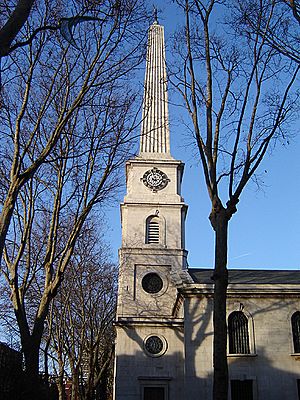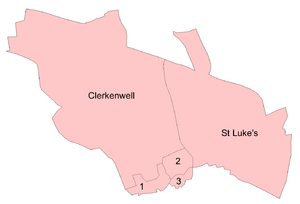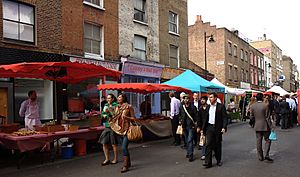St Luke's, London facts for kids
Quick facts for kids St Luke's |
|
|---|---|
 St Luke's Church, Old Street |
|
| OS grid reference | TQ322824 |
| London borough | |
| Ceremonial county | Greater London |
| Region | |
| Country | England |
| Sovereign state | United Kingdom |
| Post town | LONDON |
| Postcode district | EC1 |
| Dialling code | 020 |
| Police | Metropolitan |
| Fire | London |
| Ambulance | London |
| EU Parliament | London |
| UK Parliament |
|
| London Assembly |
|
St Luke's is a cool area in London, England. It's part of the London Borough of Islington. You can find it just north of the City of London, close to places like the Barbican Estate, Clerkenwell, and Shoreditch.
This area gets its name from an old church called St Luke's Church. It's on Old Street, not far from Old Street station. The church isn't used for regular services anymore. Because of this, the church's original area was joined back with the parish of St Giles-without-Cripplegate. It had actually separated from St Giles in 1733!
Contents
Exploring St Luke's Geography
The area that used to be the St Luke's church parish stretches north from the City of London boundary all the way to City Road. A small part even goes a bit north of City Road, around the City Road Basin.
Goswell Road forms the western edge, next to Clerkenwell. The northern and eastern edges, which border the Shoreditch area in the London Borough of Hackney, are now the boundaries for the London Borough of Islington.
St Luke's is inside London's Congestion Charging Zone and the Ultra Low Emission Zone. It's also in Zone 1 for public transport. The closest tube and train stations are Barbican, Farringdon, and Old Street.
A Look at St Luke's History
The area of St Luke's, both for local government and church matters, was created in 1733. This happened when the church was built. It was separated from the larger St Giles Cripplegate area that was outside the City of London.
Because it was outside the City, many people in St Luke's didn't follow the main Church of England. Famous places like John Wesley's house and his chapel are on City Road. Also, the historic Bunhill Fields burial ground is here.
In 1751, a hospital for people with mental health issues, called St Luke's Hospital for Lunatics, was started here. It was rebuilt between 1782 and 1784 by George Dance the Younger. Later, in 1917, the land was sold to the Bank of England. They used it to print banknotes until 1958. The building was damaged during the Blitz in 1940.
The Ironmonger Row Baths are a Grade II Listed building, meaning they are historically important. They were built in 1931 as a public wash house. Turkish baths were added in 1938.
From 1889, St Luke's became part of the County of London. A local council, called a vestry, managed the area until 1899. Then, St Luke's became part of the Metropolitan Borough of Finsbury. In 1965, this borough joined with the Metropolitan Borough of Islington to form the London Borough of Islington we know today.
The old St Luke's church building is now a concert hall and practice space for the famous London Symphony Orchestra.
What's in a Street Name?
St Luke's doesn't have exact borders, but it's roughly shaped like a triangle. Its edges are City Road and Finsbury Pavement/Finsbury Square to the east, the City of London boundary to the south, and Goswell Road to the west. Many street names tell interesting stories about the area's past!
- Anchor Yard – Named after an old inn that used to be here.
- Angel Gate
- Baldwin Street – Named after Richard Baldwin, who was a treasurer at St Bartholomew's Hospital when the street was built in 1811.
- Baltic Street East and Baltic Street West – Built around 1810 by a timber merchant. He named them after the Baltic softwood trade, which was important for his business.
- Banner Street – Named after the Banner family, who owned land here in the late 1700s.
- Bartholomew Square – Built in 1811 on land owned by St Bartholomew's Hospital.
- Bastwick Street – The reason for this name is unknown, but it might be after a place called Bastwick in Norfolk.
- Bath Street – Named after the former Peerless Pool, which became a bath. It was once called Pest House Row because a hospital for plague victims was built here during the Tudor era.
- Beard Street
- Bunhill Row – Named after the nearby Bunhill Fields cemetery. The original name was likely 'bone hill'.
- Cahill Street – Thought to be named after a person who helped redevelop this area in the 1880s.
- Cayton Place and Cayton Street – Renamed in 1805 after a village in Yorkshire to avoid confusion with other "New Street" names.
- Central Street – Named in 1861 because it was in the middle of St Luke's Parish.
- Chequer Street – Named after an old tavern called Chequers.
- Cherry Tree Walk
- Chiswell Street – An old term for stony or gravelly earth, or possibly from 'Choice Well', meaning a source of clean water.
- City Road – It connects Islington to the City of London.
- Crescent Row – Named for its curved shape.
- Dingley Place and Dingley Road – Named after Charles Dingley, who helped start the building of City Road in 1756.
- Domingo Street – Built by a timber merchant around 1810. Domingo is another name for Hispaniola, a place where mahogany wood came from.
- Dufferin Avenue and Dufferin Court – Thought to be named after a person who helped redevelop this area in the 1880s.
- Errol Street – Also thought to be named after a person who helped redevelop this area in the 1880s.
- Europa Place – The reason for this name is unknown.
- Exchange Street – Named after the old Clerkenwell Telephone Exchange.
- Featherstone Street – Named after the Featherstone family, who owned land here after Matthew Featherstone bought it in 1732.
- Finsbury Pavement, Finsbury Square and Finsbury Street – Named after an old Saxon settlement owned by someone called Finn.
- Fortune Street – Named after the Fortune Playhouse, an old theatre that used to be here. It closed in 1648.
- Fredericks's Row
- Galway Street – Named after Henri de Massue, Earl of Galway, who was the first leader of the French Hospital that used to be here.
- Gard Street – Named after a member of the nearby Orphan Working School.
- Garrett Street – Named after a person who was part of the local parish's Works Committee.
- Gee Street – Named after Osgood Gee, who built the street in 1784.
- George Gillett Court – Named for George Gillett, a local politician in the early 1900s.
- Golden Lane – Used to be called Goldynglane, likely after a local property owner named Golding or Golda.
- Goswell Road – The origin of this name is debated. Some say it's from a garden called 'Goswelle' or 'Goderell'. Others think it comes from "God's Well" or an old 'Gode Well' here.
- Hall Street – Named after James and Joseph Hall, who built the street in 1822.
- Helmet Row – Named after the Worshipful Company of Ironmongers, who owned this land. Their coat of arms has a helmet.
- Honduras Street – Built by a timber merchant around 1810. Honduras was a place where mahogany wood came from.
- Hull Street – Named after William Hulls, who built it in the 1700s.
- Ironmonger Passage and Ironmonger Row – Named after the Worshipful Company of Ironmongers, who owned this land.
- King Square – Built in 1820 and named for George IV.
- Lamb's Buildings and Lamb's Passage – Named after William (or Thomas) Lamb, who owned it in the early 1800s.
- Lever Street – The reason for this name is unknown.
- Lizard Street – Named after the Worshipful Company of Ironmongers, who owned this land. Their coat of arms includes a salamander.
- Ludlow Street – The reason for this name is unknown.
- Macclesfield Road – Named after George Parker, 4th Earl of Macclesfield, who was in charge of the canal company in the 1600s.
- Mallow Street – Named after a field of mallow plants that used to be here.
- Martha's Buildings
- Masons Place and Masons Yard
- Memel Court and Memel Street – Built by a timber merchant around 1810. Memel was a port in Germany (now Klaipėda in Lithuania) known for exporting timber.
- Mitchell Street – Named after John Mitchell, who gave this land to the Worshipful Company of Ironmongers in 1527.
- Moor Lane – Named after the marshy moorlands that used to be here.
- Mora Street – Named after the prebend of Moor/Mora, which belonged to St Paul's Cathedral and was named for the local moors.
- Moreland Street – Named after the Moreland family, who were important locally in the 1800s.
- Mount Mills – Named after a former hill here that had a windmill. It was flattened in 1750.
- Nag's Head Court – Named after an old inn.
- Nelson Passage – Named after Admiral Horatio Nelson.
- New Charles Street – This street used to lead to a Charles Street, which was named for King Charles II.
- Norman Street – Named after William Norman, a bricklayer who leased land here in the 1750s.
- Old Street – Named because it's a very old road, possibly dating back to Roman times.
- Paton Street – The reason for this name is unknown.
- Pear Tree Street – Named after the pear trees that used to grow here.
- Peerless Street – Named after the Peerless Pool, a bath used in the 1700s. It might be a changed version of ‘perilous’.
- Pickard Street – Named after a clergyman who started the Orphan Working School here in 1754.
- President Street
- Radnor Street – Named after the Earls of Radnor, who led the French Hospital that used to be here.
- Red Cow Lane
- Ropemaker Street – Named after the rope-making trade that used to happen here.
- Roscoe Street – Thought to be named after a person who helped redevelop this area in the 1880s.
- St Agnes Well – Named after an old well thought to be about 200 meters east, near Old Street and Great Eastern Street. You can still find parts of the well inside Old Street station.
- St Luke's Close – Named after the nearby St Luke Old Street church.
- Seward Street – Named after Edward Seward, who owned a dye works here in the 1700s.
- Sidney Grove
- Sundial Court
- Sutton's Way
- Sycamore Street – Possibly named after the nearby Timber Street, or an inn.
- Timber Street – Built by a timber merchant around 1810, named after his business.
- Wakley Street – Named after Thomas Wakley, a surgeon and social reformer from the 1800s.
- Warwick Yard – The reason for this name is unknown.
- Whitecross Street – Named after a white cross that stood nearby in the 1200s.
- Withers Place – Named after William Withers, who owned property here in the 1700s.
- Youngs Buildings – Named after Francis Young, who owned property here in the 1700s.
Whitecross Street Market: A Lively Spot
Whitecross Street Market is a fun market with lots of stalls. It's set up on Whitecross Street, which is closed to traffic during market hours. You can find a small general market there every weekday. On Thursdays and Fridays, it becomes a bigger food market. Sometimes, they even have special food festivals!
This market has been around since the 1600s. It used to be one of London's biggest Sunday markets, but now it's mostly busy during lunchtimes.
St Luke's Parochial Trust: Helping the Community
St Luke's Parochial Trust is a very old charity that still works in the St Luke's area today. Its main goal is to make life better for local people. It started way back in the 1500s with gifts of land and money from people who wanted to help the old church parish.
The charity now owns and runs a busy community center on Central Street. This center offers many different activities and services for the community.
The community center building was originally the Central Street Board School. This was one of many schools built and managed by the London School Board during the Victorian era. The school closed during the Second World War because local children were sent to the countryside to stay safe from the Blitz. After the war, it reopened as the Frank Barnes School for the Deaf until the mid-1970s. St Luke's Parochial Trust bought the building in 1979 and turned it into the community center. Queen Elizabeth II officially opened it in 1982!
Getting Around St Luke's: Transport
The closest stations for getting around are Barbican, Farringdon, Moorgate, and Old Street. These stations are on the London Underground Northern line (City branch). You can also find National Rail services on the Northern City Line (run by Great Northern) at Old Street station, which is on the eastern edge of St Luke's.




